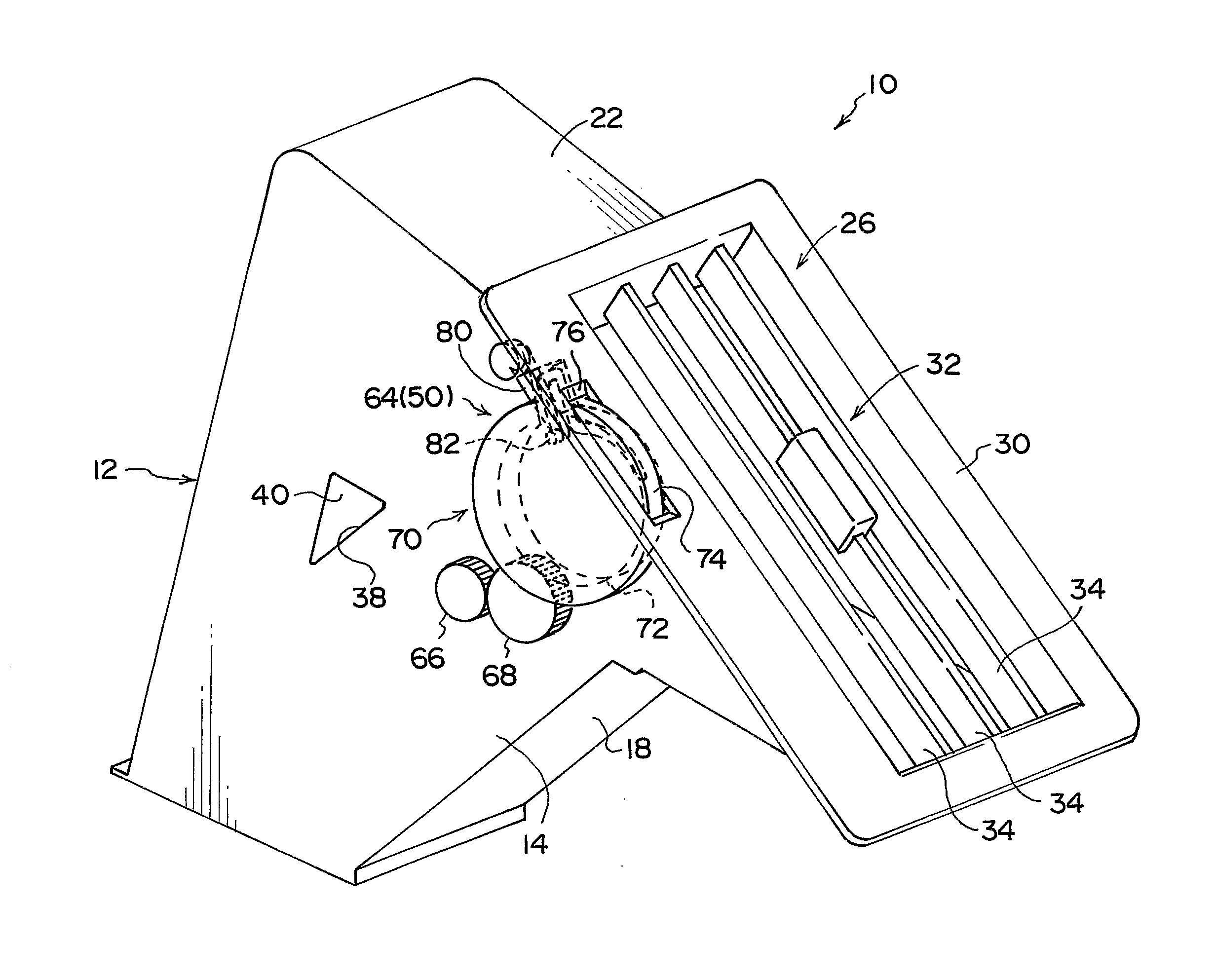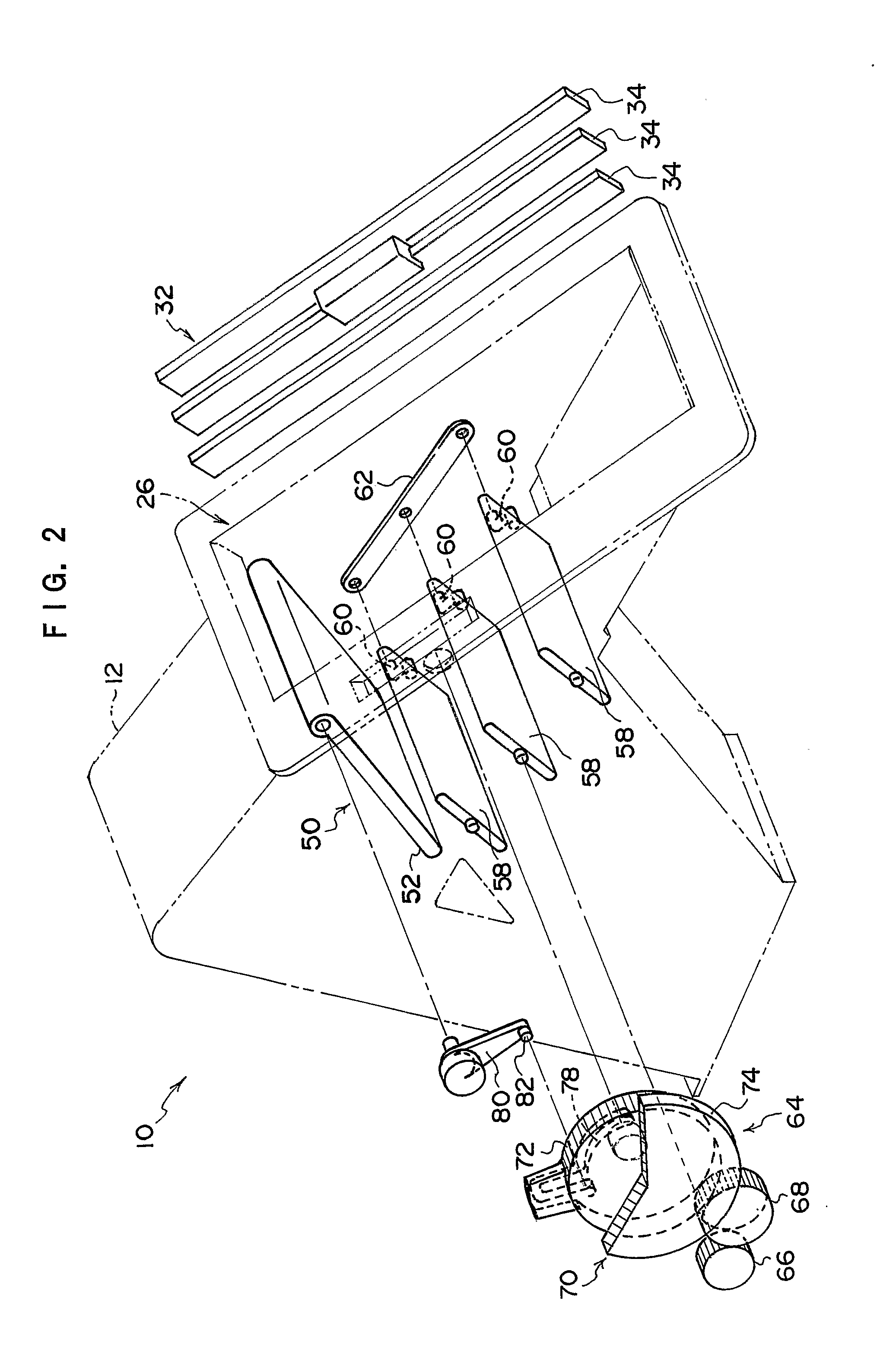Air conditioning register
a technology for air conditioners and registers, which is applied in the direction of domestic cooling devices, vehicle heating/cooling devices, vehicle components, etc., can solve the problems of difficult to improve the blow-out efficiency of air-conditioned air, and achieve the improvement of the rigidity of the fin, the appearance of the external air blow-out port, and the effect of maintaining rigidity
- Summary
- Abstract
- Description
- Claims
- Application Information
AI Technical Summary
Benefits of technology
Problems solved by technology
Method used
Image
Examples
first exemplary embodiment
Operation of First Exemplary Embodiment
[0078]The operation of the present exemplary embodiment will be described next.
[0079]In the air conditioning register 10 relating to the present exemplary embodiment, when the operation dial 70 is operated and rotated in one direction around the axis thereof, interlockingly with the rotation of the operation dial 70, the first damper 52 rotates, and the longitudinal direction other end portion of the first damper 52 approaches the top wall 22. Further, when the operation dial 70 is rotated in this way, the second dampers 58 rotate interlockingly therewith. As shown in FIG. 3, when the first damper 52 rotates to being accommodated in the accommodating portion 54, the short-side directions of the respective second dampers 58 are as close as possible to the direction from the distal end portion of the abutting piece 56 to the top end portion of the inclined wall 18.
[0080]In this state, as described above, the adjacent second dampers 58 overlap one...
second exemplary embodiment
Operation of Second Exemplary Embodiment
[0104]The operation and effects of the present exemplary embodiment will be described next.
[0105]In the air conditioning register 90 relating to the present exemplary embodiment, when the operation dial 118 is operated and rotated around its axis, interlockingly with the rotation of the operation dial 118, the gear 134 rotates, and the shutter 102 moves forward or rearward. Therefore, when the operation dial 118 is operated and rotated as greatly as possible in one direction around the axis thereof, as shown in FIG. 7, the majority of or all of the shutter 102 is accommodated at the lower side of the top wall 106. On the other hand, when the operation dial 118 is operated and rotated as greatly as possible in the other direction around the axis thereof, as shown in FIG. 9, the majority of or all of the shutter 102 is pulled-out from the top wall 106.
[0106]When the operation dial 118 is operated and rotated in the one direction around the axis ...
third exemplary embodiment
[0117]A modified example of the second exemplary embodiment will be described next as a third exemplary embodiment.
[0118]The structure of main portions of an air conditioning register 147 relating to the present exemplary embodiment is shown in a perspective view in FIG. 11. The structure of the main portions of the air conditioning register 147 is shown in a cross-sectional view in FIG. 12. Note that the main portions of the air conditioning register 147 shown in FIG. 11 and FIG. 12 are portions of the extended wall 98 and the rear wall portion 110D of the peripheral wall 110 of the air conditioning register 90 of the above-described second exemplary embodiment. At regions other than the regions where the structures differ from the air conditioning register 90, the structures are the same as the air conditioning register 90.
[0119]As shown in FIG. 7, at the air conditioning register 90 relating to the above-described second exemplary embodiment, the outer diameters of the shaft port...
PUM
 Login to View More
Login to View More Abstract
Description
Claims
Application Information
 Login to View More
Login to View More - R&D
- Intellectual Property
- Life Sciences
- Materials
- Tech Scout
- Unparalleled Data Quality
- Higher Quality Content
- 60% Fewer Hallucinations
Browse by: Latest US Patents, China's latest patents, Technical Efficacy Thesaurus, Application Domain, Technology Topic, Popular Technical Reports.
© 2025 PatSnap. All rights reserved.Legal|Privacy policy|Modern Slavery Act Transparency Statement|Sitemap|About US| Contact US: help@patsnap.com



